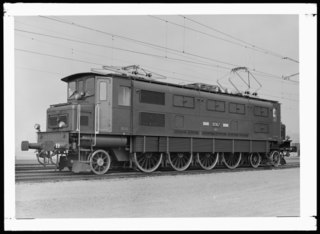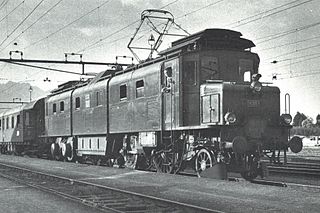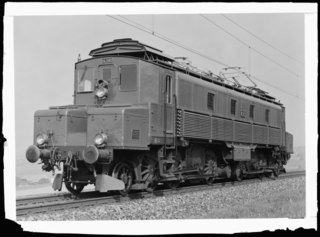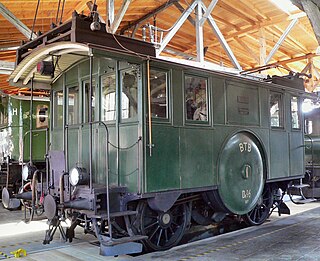

The Winterthur universal drive or SLM universal drive (German : Universal-Antrieb Winterthur) was a drive for electric locomotives invented by Swiss engineer Jakob Buchli at Swiss Locomotive and Machine Works (SLM) in the 1920s.


The Winterthur universal drive or SLM universal drive (German : Universal-Antrieb Winterthur) was a drive for electric locomotives invented by Swiss engineer Jakob Buchli at Swiss Locomotive and Machine Works (SLM) in the 1920s.
After developing the successful Buchli drive at Brown, Boveri & Cie (BBC), Buchli moved to SLM at Winterthur in 1924, where he designed the universal drive. It was characterised by double gearbox, which enabled the transmission ratio to be selected freely within a wide range. [1] Two coaxially opposed motors were arranged in the frame above each drive axle. The driving wheels were driven by a double gearbox, the second being connected centrally to the driving wheels by means of a universal joint. [2]
The Winterthur universal drive was extensively used by SLM in locomotive designs from 1928 to 1948. [3] It was compact and had a relatively light unsprung weight. However, it was difficult to access for maintenance and repair work, a particular problem as the gears were prone to wear. The drive was unpopular amongst drivers due to loud noise that it made, and production was discontinued when the design was rendered obsolete with the advent of lighter motors which enabled the modern axle-hung (also known as nose-suspended due to the "nose" that transfers weight and torque to the frame), direct-drive designs. [4]
| Nationality | Operator | Class | Quantity produced | Years constructed | Manufacturer | Wheel arrangement | |
|---|---|---|---|---|---|---|---|
| GIPR | EA/1 | 22 | 1928–1930 | SLM, Metrovick | 2′Bo(A1) |  | |
| GIPR | EA/2 | 1 | 1938 | SLM, Metrovick | 2’Bo(A1) |  | |
| SBB-CFF-FFS | Ae 8/14 11851 | 1 | 1932 | SLM, MFO | (1A)A1A(A1)+(1A)A1A(A1) |  | |
| SBB-CFF-FFS | Ae 8/14 11852 | 1 | 1938 | SLM, BBC | (1A)A1A(A1)+(1A)A1A(A1) |  | |
| SBB-CFF-FFS | Ae 4/6 | 12 | 1941–1944 | SLM, BBC, MFO, SAAS | (1A)Bo(A1) |  | |
| NS | 1000 | 10 | 1948 | SLM, Werkspoor | (1A)Bo(A1) |  |

A quill drive is a mechanism that allows a drive shaft to shift its position relative to its driving shaft. It consists of a hollow driving shaft with a driven shaft inside it. The two are connected in some fashion which permits the required motion.

A jackshaft is an intermediate shaft used to transfer power from a powered shaft such as the output shaft of an engine or motor to driven shafts such as the drive axles of a locomotive. As applied to railroad locomotives in the 19th and 20th centuries, jackshafts were typically in line with the drive axles of locomotives and connected to them by side rods. In general, each drive axle on a locomotive is free to move about one inch (2.5 cm) vertically relative to the frame, with the locomotive weight carried on springs. This means that if the engine, motor or transmission is rigidly attached to the locomotive frame, it cannot be rigidly connected to the axle. This problem can be solved by mounting the jackshaft on unsprung bearings and using side-rods or chain drives.

The Buchli drive is a transmission system used in electric locomotives. It was named after its inventor, Swiss engineer Jakob Buchli. The drive is a fully spring-loaded drive, in which each floating axle has an individual motor, that is placed in the spring mounted locomotive frame. The weight of the driving motors is completely disconnected from the driving wheels, which are exposed to movement of the rails.

The Nederlandse Spoorwegen (NS) Class 1000 was a set of ten electric locomotives used in the Netherlands during the latter half of the 20th century. The electrical systems and three completed units were ordered from the Swiss Locomotive and Machine Works in 1942, but the war blocked delivery until 1948. Despite high failure rates the locomotives remained in service until 1982, and locomotive 1010—built by Werkspoor—is now preserved in the Dutch National Railway Museum.

The Ae 4/7 was a universal locomotive of the Swiss Federal Railways, employing the so-called Buchli drive.

Jakob Buchli was a Swiss design engineer in the field of locomotive construction.

The Ae 4/8 was a prototype locomotive of the Schweizerischen Bundesbahnen (SBB) for the testing of electrical operation. The locomotive was equipped with two different drives, therefore acquiring the nickname Bastard. Because of its three-part locomotive body it also acquired the nickname Tatzelwurm.

The Rhaetian Railway Ge 2/4 was a class of metre gauge 1′B1′ electric locomotives formerly operated by the Rhaetian Railway (RhB), which is the main railway network in the Canton of Graubünden, Switzerland. Four members of the class are now preserved, with one of them in operational condition.

The Ce 6/8 I 14201 was one of four test locomotives ordered by the Schweizerischen Bundesbahnen (SBB) in June 1917. For gaining experience for ordering electrical locomotives this locomotive should – as its three siblings Be 3/5 12201, Be 4/6 12301 and Be 4/6 12302 – have been used for services on the Gotthardbahn. The development of freight locomotives subsequently took a completely different way which was not conceivable at the ordering date. The Ce 6/8I came into service only after the first Ce 6/8II.

SNCF 232.P.1 was an experimental prototype high-pressure steam locomotive ordered by the Chemins de fer du Nord, but delivered to the Société nationale des chemins de fer français (SNCF) in 1939. It was the first and only member of SNCF's first class of 4-6-4 or Hudson type of locomotives.

The Swiss locomotive class Ae 4/6 was a class of electric locomotives. They were intended as a powerful locomotive for the steep gradients of the Gotthard Railway, but smaller than the huge 'double locomotives' which had previously been tested there. They were built from 1941, during World War II, and although Switzerland remained neutral through this, material shortages led to some quality problems with these locomotives.

The Tschanz drive or Oerlikon single-axle drive is a fully sprung single-axle drive for electric locomotives named after its inventor Otto Tschanz or after Maschinenfabrik Oerlikon. The drive was not widely used because its competitor, the Buchli drive, was cheaper and lighter.

The BTB E2E, also known as F 2/2 and De 2/2, were a pair of Swiss electric locomotives operated by Burgdorf Thun Bahn (BTB) in the early twentieth century. They are the oldest three phase locomotives designed for full service operation that have been preserved. The locomotives were built by Brown, Boveri & Cie (BBC) and Schweizerische Lokomotiv- und Maschinenfabrik (SLM) and entered service in 1899. They were powered by two 110 kW (150 hp) 750V AC electric motors which drove two axles. A two speed gearbox enabled the locomotives to travel at 18 km/h (11 mph) and 36 km/h (22 mph), the latter for passenger transport. The gearbox was later upgraded, raising the speed to 50 km/h (31 mph). Relegated to secondary duties when more powerful designs were introduced, the locomotives provided valuable service until 1930.

Rigid-framed electric locomotives were some of the first generations of electric locomotive design. When these began the traction motors of these early locomotives, particularly with AC motors, were too large and heavy to be mounted directly to the axles and so were carried on the frame. One of the initial simplest wheel arrangements for a mainline electric locomotive, from around 1900, was the 1′C1′ arrangement, in UIC classification.

The Java bogie, was a bogie for electric locomotives manufactured by the Swiss Locomotive and Machine Works (SLM). It contained a driving wheel and a trailing wheel. It got its name because it was first installed in the 3000 series express train locomotives delivered to the Electrische Staats Spoorwegen (ESS) on Java in 1925.

The Indian locomotive class WCP-1 is a class of 1.5 kV DC electric locomotives that was developed in late 1920s by Swiss Locomotive and Machine Works (SLM) for Indian Railways. The model name stands for broad gauge (W), Direct Current (C), Passenger traffic (P) engine, 1st generation (1). They entered service in 1930. A total of 22 WCP-1s were built in England between 1928 and 1929.

The Indian locomotive class WCP-4 was a single-member class of 1.5 kV DC electric locomotive that was developed in late 1920s by Swiss Locomotive and Machine Works (SLM) for Indian Railways. The model name stands for broad gauge (W), Direct Current (C), Passenger traffic (P) engine, 4th generation (4). The locomotive was built at England between 1928 and 1929, and entering service in 1930.
The Indian locomotive class WCP-3 was a single-member class of 1.5 kV DC electric locomotive that was developed in late 1920s by Hawthorn Leslie for Indian Railways. The model name stands for broad gauge (W), Direct Current (C), Passenger traffic (P) engine, 3rd generation (3). The locomotive was built at England between 1928 and 1929, and entering service in 1930.

The Indian locomotive class WCP-2 is a class of 1.5 kV DC electric locomotives that was developed in late 1920s by Swiss Locomotive and Machine Works (SLM) for Indian Railways. The model name stands for broad gauge (W), Direct Current (C), Passenger traffic (P) engine, 2nd generation (2). They entered service in 1938. A single WCP-1 was built at England in 1938.